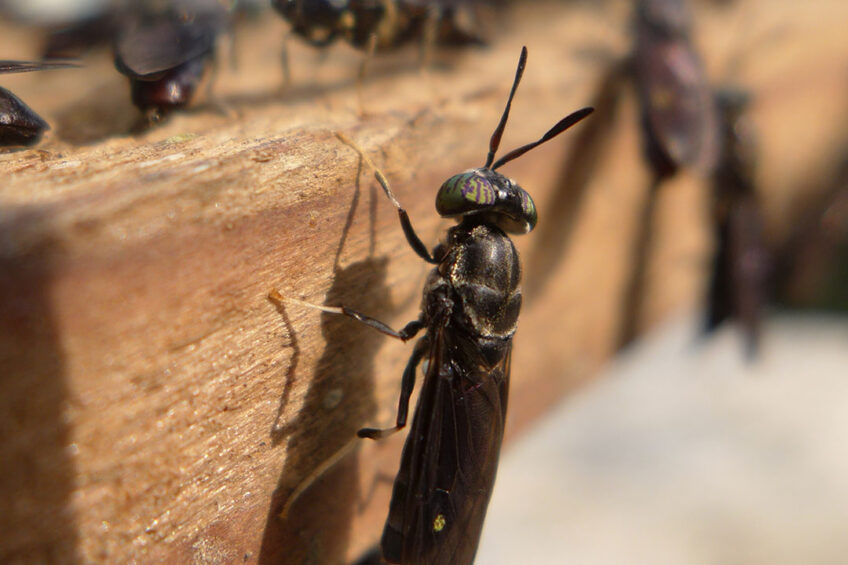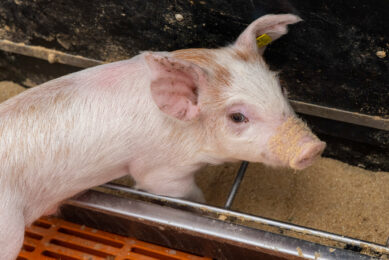Black soldier fly larvae as edible enrichment

The black soldier fly (BSFL) offers a range of opportunities for pigs, not only as a feed ingredient, but also as edible enrichment. Providing small daily portions of live BSFL to piglets after weaning has benefits for their behaviour while maintaining performance.
Commercial piglets are often abruptly weaned at an early age, when they are not yet accustomed to eating solid feed. The unfamiliarity with solid feed combined with the stress piglets experience during weaning often leads to diminished feed intake after weaning. That in turn can stall growth or even result in weight loss in the days following weaning, and is often associated with post-weaning diarrhoea. When piglets are housed in barren pens after weaning, they also tend to show manipulative behaviours towards pen fixtures and other piglets, diminishing piglet welfare. A recent exploratory study, conducted by Wageningen University & Research in cooperation with Bestico, ForFarmers and HatchTech, investigated whether providing small amounts of live BSFL after weaning could ease the weaning transition and improve piglet performance and welfare after weaning.
Multifunctional larvae
BSFL are high in moisture, fat and protein with an amino acid profile suitable for inclusion in pig feed. Because of their high palatability and water content, they could function as a transitory feed between milk and concentrate, allowing piglets to steadily get used to eating solid feed. BSFL also possess many characteristics that are generally attractive to piglets, such as being edible, odorous, manipulable and destructible. Interacting with BSFL could satisfy the motivation of piglets to explore their surroundings, thereby decreasing the tendency to manipulate and potentially harm other piglets. Akin to other types of enrichment materials, regular interaction with BSFL could habituate piglets to novelty, decreasing piglet fearfulness and stress.
Experimental approach
In this study, 16 pairs of unfamiliar piglets were housed in pens with a wood shavings bedding, from weaning until day 11 after weaning. All piglets had ad libitum access to a pelleted weaner feed. In half of the pens a small amount of live BSFL (75 g on days 1–4 and 150 g on days 5–11) was scattered through the pen twice a day, and in the other pens a similar volume of wood shavings was scattered at the same time to control for the effect of disturbance.
Piglet growth and feed intake were measured regularly. On days 2, 5 and 8 after weaning, the behaviour of all piglets was observed throughout the day, and at the end of the experiment all piglets were tested for their level of neophobia by introducing them to an unknown environment and an unknown object and observing their behavioural responses.
Piglet performance
Table 1 shows an overview of the piglets’ performance. Providing BSFL to piglets for 11 days after weaning did not affect the piglets’ daily growth or their weight at the end of the period. Visual inspection of the wood shavings in the pens indicated that the piglets consumed the bulk of the provided BSFL in a short period of time, which was expected because of the high palatability of the larvae. Piglets provided with BSFL did have reduced pellet intake compared with control piglets for several days after weaning, and in line with this the behavioural observations indicated that they spent less time on eating pellets.
However, when BSFL consumption was included in the calculation, the total dry matter intake did not differ between treatments. The total energy intake and the energy and feed efficiency were also not affected by providing larvae.
Those results indicate that live BSFL can be a substitute for part of the diet of piglets without hindering their performance. Previous studies have already demonstrated that including BSFL meal in pig diets can have neutral or positive effects on pig performance, and this study confirms that this also holds true for whole, live BSFL provided to weaner piglets.
It is important to note that here only a relatively small amount of live BSFL was provided, and ad libitum BSFL provisioning may have different effects. Directly after weaning, when solid feed intake is often low, ad libitum BSFL provisioning could improve nutrient intake in this critical period. This in turn might support long-term good intestinal integrity and growth. When a substantial part of the diet is replaced with larvae, the nutrient composition of the pelleted feed will have to be adjusted to guarantee adequate pig performance.
Piglet welfare
Key results from the behavioural observations are shown in Table 2. Across the three days during which piglet behaviour was observed (days 2, 5 and 8 after weaning), piglets that received BSFL spent less time exploring and manipulating pen fixtures and other piglets than the piglets that received wood shavings. The presence of BSFL also caused the piglets to spend much of their time exploring the litter where the larvae were located.
It is interesting that this shift towards more favourable, less damaging behaviours occurred despite the BSFL being present for only a short period twice a day. Also, the piglets in this experiment were housed under relatively good conditions, with bedding and a lot of space. In more barren commercial pens, which can lead to more welfare problems related to damaging behaviours, the provision of BSFL probably has even greater benefits for piglets.
When confronted with an unknown environment containing an unknown object, piglets in the BSFL treatment exhibited more exploratory behaviour towards the object and spent less time freezing, indicating a reduced neophobic response.
It is possible that the rewarding feedback caused by exploring and consuming BSFL creates positive associations with novelty in these piglets, making them more able to cope with unfamiliar situations. Such skills can be beneficial, as commercial piglets housed in large groups often come across changes in their physical and social environment.
What comes next?
The current exploratory study successfully demonstrated that providing small amounts of live BSFL daily to piglets after weaning can improve piglet welfare while maintaining piglet performance. The next logical step is to investigate whether these effects also hold for piglets housed under more barren commercial conditions. Experimenting with different amounts of BSFL provided in different ways in these conditions, and combining this with research on nutrient uptake and the digestibility of larvae, will help construct a complete picture of the value of BSFL as both feed and enrichment. Additionally, the effects of providing BSFL during different phases of pig rearing are yet unknown. Providing BSFL before weaning may further ease the weaning transition, and later in life BSFL can be a high-quality feed source that can support pig performance. Overall, the prospects of using BSFL as edible enrichment are clear, although more research is needed before commercial application is possible.
Author
Allyson Ipema PhD, Adaptation Physiology group, Wageningen University & Research, the Netherlands











